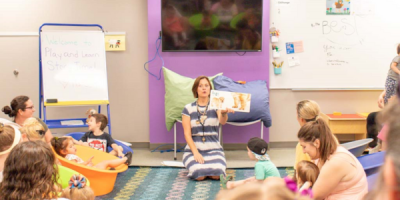
As your young child grows, you may hear the term “fine motor” or “fine muscle” development. What do these words mean and why are they important? What do they have to do with early literacy?
Fine Motor/Muscle Development:
Healthline defines ‘fine motor’ skills as those that “involve movement of the smaller muscle groups in your child’s hands, fingers, and wrists.” These muscles are essential to a child’s independence. Fine motor skills allow a child to complete such activities as brushing their teeth, tying their shoes, or zipping a jacket.
Fine Motor/Muscle Development & Early Literacy Development
Early literacy development is also affected by the presence of fine motor skills. “Reading and writing are inseparable skills that work together while supporting each other,” Carnegie Library of Pittsburgh states. “Developing and practicing fine motor skills is an effective way to prepare young children for writing (and learning) letters and numbers in the future.” Without appropriate fine motor skill development, a child will struggle with holding and using writing utensils like pencils and crayons. They will also have trouble using scissors and other tools.
Children need fine motor skills to control the small muscles necessary to move their hands and fingers. These muscles are critical for writing, which is a main component of literacy. “Fine motor activity in the early years,” highlights Exceed: Rhode Island’s Early Childhood Commitment, helps children refine their pincer grasp (grasping an object with their thumb and pointer finger using their preferred hand) and are a precursor to handwriting… Many children who do not have strong small motor skills become more easily frustrated while doing tasks that require writing which can lead to poor self-esteem, anxiety and stress.”
How Can I Help My Child Develop Their Fine Motor Skills?
There are a number of different ways to help your child develop their fine motor skills. For instance, you can provide opportunities for your child to use Play Doh or to string beads or cereal on a pipe cleaner or string. Let children practice dressing themselves - complete with ties, zips, and snaps! Giving your young child a piece of paper to rip apart is another method used to strengthen their small hand and finger muscles. Help your child also safely practice using scissors and allow them to use writing implements like crayons and paint brushes. Encourage your child to point to different items and to pick things up, both large and small items. Find books that require your child to trace a pattern with their fingers or lift flaps. Such books include Can You Turn the Page? by Janice Behrens, Dear Zoo by Rod Campbell, Welcome, Baby! by Karen Katz, Counting With a Ladybug by James Mitchem, and Trucks by Dawn Sirett. For additional ideas on how to help your child develop their fine motor skills, please visit this link from the National Association for the Education of Young Children.